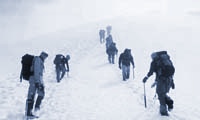|
The purpose with secure is that you shall prevent falling and get hurt. Which technique you use depends on the terrain and how many you are in the team. When you get more experienced it's much easier to see what is suitable.
Before you do something you must think of the consequences? Perhaps another route is better to minimize the risks. The amount of the team is synonymous with your safety. Small teams are more exposed.
|

|
|
You pass over crack areas at right angles otherwise you risk dragging the whole team down. The conclusion is that you must be able to read the terrain. The conclusion is that you must be able to read the terrain.
|
|
|
The easiest way to shorten the team is to use the force knot (Prusik) you have on the rope.
When you want to enlarge you just hold on the knot. It's a useful method when passing cracks.
|
|
|
When you pass more difficult areas you can use an extra anchor, for example in steep hills or narrow ridges.
The terrain in it self can also be used as an anchor. The meaning with extra anchor is to prevent long falls and that the whole team falls.
The ordinary way is that the first in the team place an anchor and last one remove it. This method takes, as you see, long time.
|
|
|
If you are using screw carbines with a pulley when rescuing, you must have enough spare rope in the back pack; otherwise the rescue work won't work.
|
Intro | Facts | Equipment | Knots | Safety technic | Comrade rescue
|